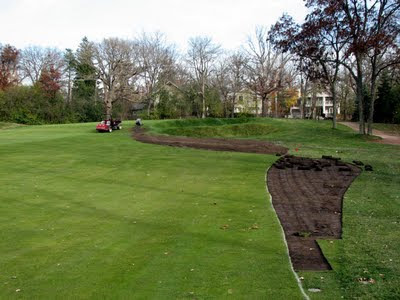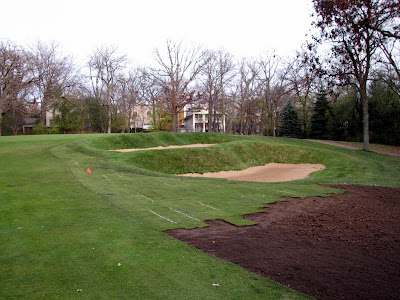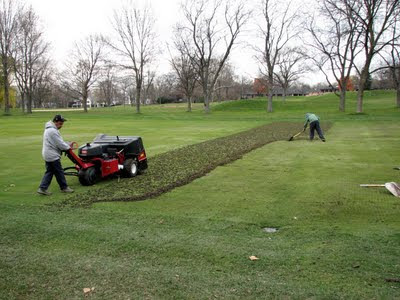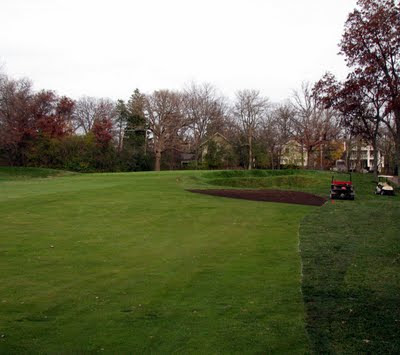In just a little over a week the combined efforts of Wadsworth Golf Construction and Skokie Grounds Operations Staff have completed the Bunker and Mound Project at #18. With great weather and a few very long days we just may have set a record for building and grassing this new complex!
Over the weekend the bunker shapes, shoulder elevations, drainage, irrigation modifications, mounded ridge shaping, topsoil placement, and most of the sod installation was completed.
Irrigation and shoulder (face) sod being installed
Drainage in place and shoulder sodding progressing
Topsoil replacement on mounded ridge
Monday the sand was installed, final sodding of the mounded ridge completed, and the haul road (where all traffic was confined during construction) was tilled, leveled and seeded. Also, with areas where the fairway has now shifted from original, we replaced all fairway sod that was lifted prior to construction. There was a net increase in fairway width, and rather than bring in sod that would not match the existing fairway turf varieties, we used our "home-grown" sod, planted from cores at our nursery, which will much more closely match the existing turf varieties in the adjacent areas on #18 fairway. This is the same method as we have used with other fairway expansions (see last post), but in this case rather than grow in place we used sod available at our nursery.
Shoulder sod complete, fairway expansion begins
Sand installed, fairway replacement and expansion complete
Haul road tilled and prepped for seeding
The few final details were completed on Tuesday and included smoothing and compacting the bunker sand, fertilizing and applying wetting agents to aid moisture retention for the new sod and seed, and covering the seeded, former haul road with a straw blanket. This late seeding is what's considered 'dormant seeding', and germination will not take place now but the seed will be in place and will do so as soon as the soil warms in the spring. With these final few items addressed today, I guess I can say for this project,...that's a wrap!
Straw blanket in place to prevent erosion and protect seeds
Fairway expansion at first bunker, sand smoothed and compacted
A few details about the new complex:
As I mentioned in an earlier post, the new bunkers approximately split the location of the former bunker. The new far bunker is approximately 10 yards further from the tee, and the new closest bunker is approximately 10 yards closer. A low shoulder or face separates the two, and a formidable shoulder on the far bunker gives true meaning to the term "hazard"! An off line shot entering the first bunker will have a much more manageable recovery shot. If a player challenges the far bunker and is skilled enough to carry 295 yards he'll be rewarded by a nice "kick" off the back slope, where fairway lies beyond, receiving a good amount of additional yardage.
The mounded ridge short of the bunkers is a continuation of the ridge that was existing between the former bunker and the existing grass bunker on #1 side. The sloped areas of the mounded ridge will add challenge to shots hit wide right off both #1 and #18 due to potential uneven stance. There is a generous amount of fairway and flat rough in these areas and this should only affect shots hit rather far off line.
I believe this entire new complex looks very attractive (and will of course be more so when fully established) and with design similarities of that of many of our other bunkers, these "new" bunkers blend well with our overall bunker style.
Complex complete - Attractive but.."A hazard to be avoided"!
Enjoy the view but remember bunkers are hazards, and in the words of architect Donald J. Ross, "Regardless of where a bunker may be, it is the business of the player to avoid it"!


















































